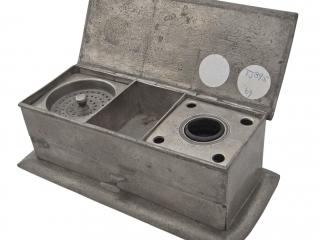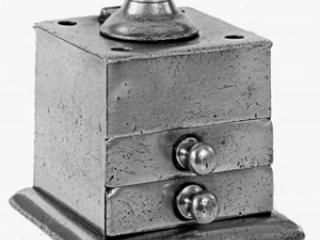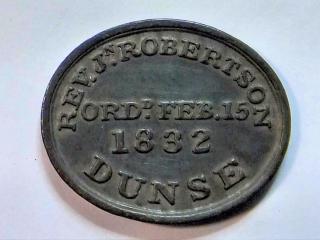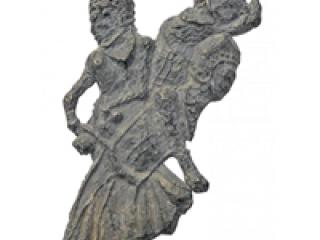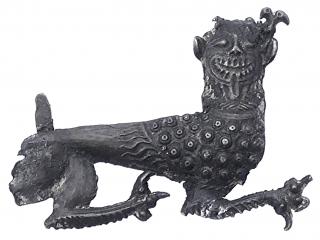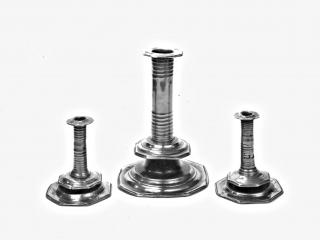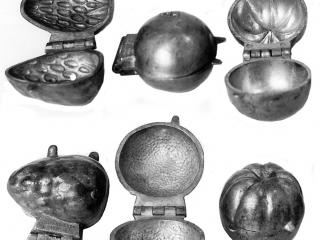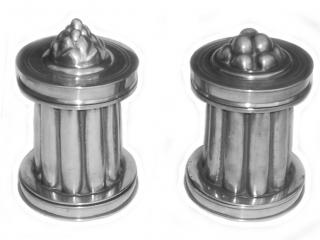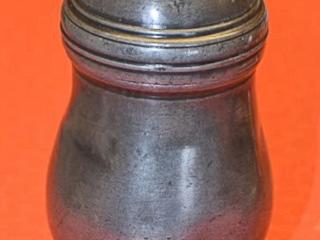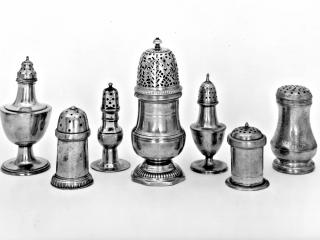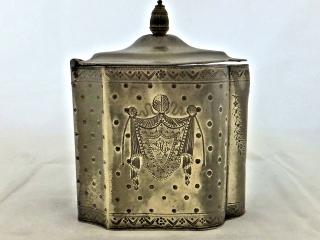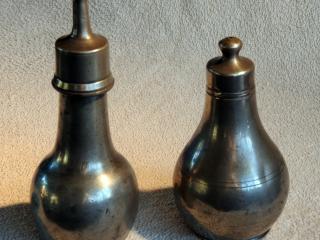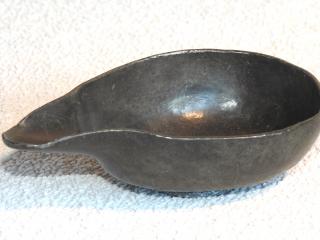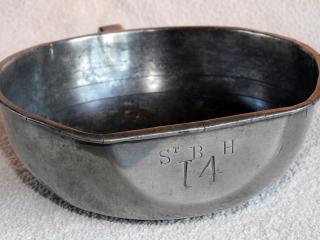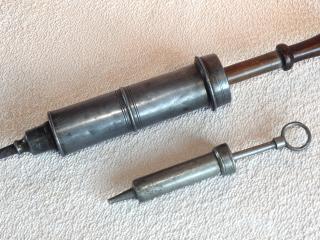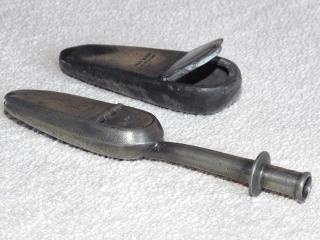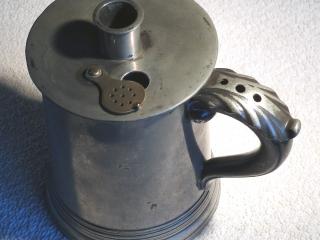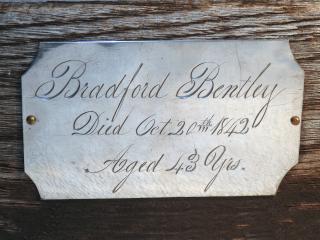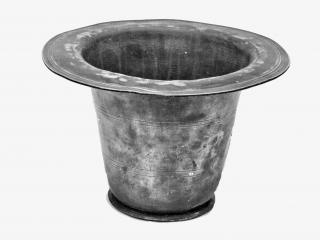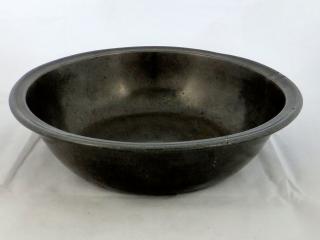Other pewter ware
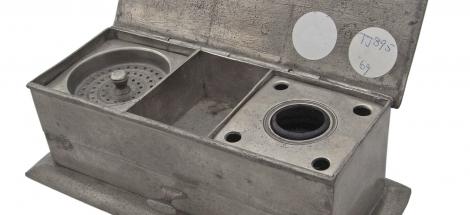
The categories outlined below are those used by the Pewter Society database.
Inkstands
The scribe needed ink, which he made up from a powder and his pen was a quill cut from a goose feather. Even the Victorian clerk had to have a bottle of ink at hand for use with his new steel nib. Most desks would have had an ‘ink standish’ (a term that was simplified to ‘inkstand’ by the end of the 18th century), and pewter was a popular material for them. They were used to hold not only ink but quills, nibs, seals and ‘pounce’, a powder used to prepare the paper or blot the wet ink.
A popular style in pewter was a flat box with two lifting flaps, one covering a long container for the storage of pens, the other covering two, three or four compartments for ink pots, seals and a pounce pot. These are known as Treasury inkstands because some silver ones were ordered for the Treasury in the late C17, but the earliest surviving pewter examples date from mid C18. They were still being made at the end of C19, with reproductions continuing into C20. A variant that is encountered rather less frequently has only a single flap but with a drawer beneath.
Cube inkstands are less common . They have a lidded compartment for a glass inkpot at the top with two drawers beneath, one usually having a perforated plate so it could be used for pounce. They were made from mid C18 to mid C19 but beware, as there are a number of fakes around. On genuine examples the cover plate is held by two pins running from one side to the other.
Even rarer in pewter are trays with pots on them and, sometimes, a drawer beneath. Their rarity is surprising as this is one of the commonest styles in silver, but again be careful, as there are fakes around.
The commonest style of pewter inkstand, though, is the simple round container for holding a glass or pottery inkpot, often standing on a round flat base. They were popular throughout C19 and C20, and indeed they were still in use in banks and post offices in the 1950s, which is why so many survive.
Other styles of pewter inkstand exist, but they tend to be encountered less frequently.
Badges and tokens
Communion tokens ( from Pewter at the Royal Cornwall Museum )
Communion tokens were being used by the Protestant churches, mainly those in Scotland, during the 18th and 19th centuries. They were given out to those who were deemed suitable to receive communion at large services which only took place a couple of times a year. The name of the church and the current Minister is usually cast in the badge along with the date.
Pilgrim badges
The miracle working power of a shrine or relic could be transferred to anything that came into contact with that shrine and souvenirs thus associated were highly prized as secondary relics as well as keepsakes. They were produced from 13th century until the Reformation and often depicted an image of the saint or some pivotal moment in the life of that saint as in the images of the murder of Thomas Becket or his return from exile. The initial letter of the saint's name was a popular motif - a Lombardic letter M for Mary often with a crown above to indicate Mary Queen of Heaven; or a depiction of a shrine.
Ampullae were produced for pilgrims to take home a souvenir of a few drops of holy water associated with the saint; best known are the scalloped ampullae associated with the tomb of St James of Santiago de Compostella.
Secular badges
Badges of a non-religious association such as funerary badges, livery badges to be worn also worn by retainers of aristocratic households, or to be given as lovers' gifts were produced in large numbers. There were also badges satirising the Establishment.
Candlesticks
Pewter candle sticks have been known since the 14th Century but very few still exist, those from the 17th Century are more common with designs of a bell, circular or octagonal bases . The single column may have a knob , be twisted or have a small drip tray all ending in a socket to hold the candle. 18th Century designs followed those produced in brass but it is rare to find candlesticks from this period due to the efficient method of repetitive casting for brass candlesticks so the most common found today are those made in the 19th century .
Baluster-stem pewter candlesticks were most popular in C19 but they were first made in the late C18 and continued into C20. Pearson, Page and Jewsbury,a firm making reproduction pewter, were still featuring examples in their catalogues of ca.1926 and 1955 . They are rarely marked,which makes it difficult to establish any chronological sequence.
Ice moulds
The first references to ice cream in the UK come from a manuscript recipe of 1665 for 'Icy Creams' and from an account of the Garter Feast at Windsor in 1671 when a plate of ice cream was served to Charles ll. Printed references occur as early as the 1690s mentioning moulded ices made in the form of fruit, pyramids, bricks and fluted log shapes which then seemed to form the basis for the subsequent designs popular across Britain, Europe and America from the 18th century and well into the 20th century.
Moulds came in many shapes and sizes from individual to banqueting size. Small individual moulds E03. 04,05 were usually manufactured in two halves hinged together and represented anything from peaches, pineapples, strawberries, roses, lilies, baskets of flowers, hens, swans, lambs or even vegetables such as the potato made by Cadot of France or the Gruyère cheese by a firm called Letang, an egg in an egg cup and even a hand grenade. American companies, Schall & Co of New York and Eppelsheimer & Co produced patriotic symbols such as figures of George Washington and his wife, battleships, the stars and stripes, and an enormous banqueting size mould of the Statue of Liberty.
A distinctive type of mould known as a pillar mould became a peculiarly English style. It was usually in three parts – a top, body and a base which was perhaps a development of the 'fluted log' shape referred to in the late 17th century. It was usually round with fluted sides although oval designs can be found. The top usually represented flowers or fruit.
A more elaborate development of this was the hinged mould with a top and base, open often representing a basket of flowers and known as a Catherine mould. Sorbetières were plain sided containers used for the initial stages of making ice cream. The ice cream was put into a sorbetière which could then be put into a bucket of ice with added salt to help speed up the freezing process. When the ice cream was ready it would be taken out and put into the chosen mould.
Containers
Mustard and Spice Pots
Baluster shaped mustard pots, usually on a short stem and foot, were widely used in Europe from the late seventeenth century onwards. Early British examples however are unknown. Most baluster pots have a small cut-out on the lid to facilitate serving the mustard.Nineteenth century mustards are open and flat. Examples with oval, round and shaped bodies occur, usually with blue glass liners. Most are in britannia metal
Spices, prior to 1800, were used frequently at the table, for our forebears needed the pungent flavours to hide some of the less pleasant tastes of the salted or smoked meat and fish which for much of the year was all that was available. Ginger and cinnamon were the most popular spices.In the eighteenth century small spice boxes were used on European tables while in the late eighteenth and nineteenth century baluster shaped lidded spice pots with loose fitting or screw lids were popular.
Sifters and Peppers
The use to which “sifters” were put is not always easy to determine. Where the holes are large the sifter was probably intended for sugar, small apertures implying spices or pepper. In early sifters the holes are roughly cut but after 1700 — 20 they are neatly drilled. Complete sets of three “casters” occasionally occur. Most sifters derive their shape from silver forms. The baluster style appeared in pewter around 1670 and had screw lids.Eighteenth century castors or sifters are uncommon although nineteenth century examples occur more frequently. Large quantities of small castors were made for pepper, many in britannia metal made in Sheffield or Birmingham.Owls, politicians,lighthouses and other various novelty peppers were made.
Tea Caddies
Oval tea caddies were popular in Britain in the eighteenth century, often decorated with bright cutting but these are not normally found.
Tobacco boxes, snuff boxes, bottles and flasks are also found.
Medical/Personal
Pewter was used extensively for the everyday needs of people and the care of the sick both at home and in the poor-houses, sanitaria, and hospitals. It is impossible to identify where individual pieces were used unless they were stamped or engraved and often even this has been added at a later date simply to enhance their value. Many of the institutional objects, – bowls, plates, jugs, mugs, porringers, even bed-pans, potties and urinals etc., – were identical to those found in ordinary homes, but others were modified or created specifically for treatments or to alleviate suffering.
Infant feeding bottles are an example of specifically designed items though they might have been used to give fluids to sickly adults as well. Why they come in both “short teat” and “long teat” versions is uncertain but teeth-marks on the latter are more likely to be there because, after it fell out of fashion, a shepherd used the bottle to feed his newborn lambs!
The Pap Boat was a simpler device for giving feeble folk semi-liquid food, and sadly an easier one to forge, so most are 20th C reproductions often with “Dent” or a hospital name on their handle. More sophisticated feeding mugs with extended pouring spouts come in many forms being made by Thomas Compton about 1860 and carrying the War Department broad arrow.
Small bowls, larger rimmed barbers’ bowls and even porringers with a series of lines incised inside the bowl, often with the numbers 4 – 8 – 12 – 16, alongside them (representing fluid ounces) may be classed as Bleeding Bowls, though to have the name of their place of use as well is quite unusual.
Pewter Syringes come in many sizes and one hopes that the larger ones were for veterinary purposes only! Items recovered from wrecks such as The Mary Rose have shed new light on exactly what was carried to war by the barber surgeon but we still cannot be sure of their exact use. Those with very long thin nozzel attachments might well have been used for flushing out wounds but instilling “mercury”, up the urethra, probably as mercuric chloride cream, as a misguided treatment of syphilis was certainly a common practice and not surprisingly urethral syringes have survived better than their original owners. Enema syringes are usually easily identified and there were even automatic clockwork ones which instilled the flushing fluid and played a tune whilst doing so, though these were French!
A Gibson Spoon was an ingenious device which retained the medicine in its hollow body by negative pressure before it was released into the recipient’s mouth by the giver allowing in air. It was designed – “To give laxatives to imbeciles”. Sadly, these will also be found with teeth-marks!
If ever you find what looks like an ordinary pint pub measure but with three holes in the top of the handle and one from its bottom into the mug then this is a Mudge Inhaler – probably without its lid. (illustration). When the sufferer inhaled through the flexible tube air would be sucked down the handle and through the liquid within the mug. Hot water with aromatic plants and oils would provide a humid and soothing inhalation. Keep your eyes open!
If the infant feeders represent the beginning of life then pewter coffin platesbrings us to our end. It was the custom, particularly in The States that the pioneers, having placed their loved one in their coffin would, before burial, remove the name plate to carry with them as a memento. These occasionally turn up, even today.
Commodes
Until the eighteenth century waste was thrown directly into the street, added as “night soil” to a local tip or taken away by men employed for this purpose.Widespread use was thus made at all levels of society of Chamber Pots or Commodes.
We tend to use the terms Chamber Pot and Commode interchangeably but more properly, a pot was used by itself and a commode hidden in a piece of furniture.Two forms are most frequently found; the traditional rounded pot with handle, and the “Welsh Hat” style. Most British commodes are of the “Welsh Hat” style. The earliest rounded pots can be sixteenth century but the Welsh Hat form does not appear until about 1700.
Bowls
Large narrow-rimmed bowls usually date from the late C18th to the early C19th. A hammered bouge suggests British, not continental manufacture. They were often exported to America, where they are called basins but examples turn up in the UK too. Bowls by London and Glasgow makers occur most often, but they were probably made more widely.The use of four ownership initials, rather than a triad, is common in Scotland,but it can also occur elsewhere, especially on church pieces.
